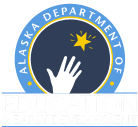- Cama-i, quyana tailuci!
- (Central Yup’ik)
- "Greetings, thank you for coming!"
School Support & Improvement
The Key Question
How can we provide a statewide system of support to promote continuous improvement across all schools and districts, as well as ensure significant evidence-based interventions in the lowest performing schools?
ESSA Highlights
ESSA § 1111(d)(1)(A)
School Identification
States must identify schools that require interventions:
- For comprehensive support:
- Schools that are in the bottom five percent
- Any high school failing to graduate 1/3 or more of its students
- For targeted support:
- Any school in which a subgroup of students is consistently underperforming
ESSA § 1111(d)(2)(A)
Comprehensive Support
Districts shall locally develop and implement a comprehensive support and improvement plan:
- Needs assessment
- Stakeholder involvement
- Formal plan
- Evidence-based interventions
- Approved by school, district, and state
- “monitored and periodically reviewed” by state
ESSA § 1111(d)(2)(B)
Targeted Support
Each school shall develop and implement a school level targeted support and improvement plan for each subgroup of students:
- Needs assessment
- Stakeholder involvement
- Formal plan
- Evidence-based interventions
- Approved and monitored by district
ESSA § 1111(d)(3)(A)(i)
Exit Criteria
States shall establish a statewide exit criteria:
- Comprehensive schools
- Applied in a state-determined number of years after designation (not to exceed four years)
- If criteria are not met, then more rigorous state-determined action takes place, such as the implementation of interventions (which may include addressing school-level operations)
- Targeted schools
- If criteria are not met, then targeted school becomes a comprehensive school
ESSA Definition
Evidence
ESSA defines four categories of evidence based on their strength:
- “Strong evidence” meaning supported by at least one randomized study;
- “Moderate evidence” meaning supported by at least one quasi-experimental study;
- “Promising evidence” meaning at least one correlation study with pretests as covariates; and
- Programs with a rationale based on “high-qualify research” or a positive evaluation that are likely to improve student or other relevant outcomes and that are undergoing evaluation.
Alaska's Current Situation
School Identification
Alaska ranks all schools from 1 star (lowest) to 5 star (highest)
- All 1, 2, and 3 star schools must create comprehensive improvement plans
- Plans for 3 star schools are submitted to the district
- All 4 and 5 star schools create plans for subgroups that missed AMO targets, graduation, or participation rate
- District oversees plans
Alaska identifies priority schools (lowest 5% of Title I schools) and focus schools (schools with low performing subgroups) for most comprehensive plans and support. Specific interventions are required for priority school plans.
Comprehensive Support
All priority, focus, and 1, 2, or 3-star schools participate in the school improvement planning process
- Based in Alaska STEPP
- Online planning and task management tool
- Needs assessment
- School level planning team
- Frameworks of "best practices"
- School plans submitted by:
- 1 and 2 star schools
- Review, approval, and feedback provided by DEED
- 3 star schools
- Review and support provided by districts
- 1 and 2 star schools
- Action and task management
Targeted Support
Any school containing a subgroup not meeting the AMO percent proficiency and attendance targets should engage in focused improvement planning, addressing the specific subgroups. This applies to all schools regardless of star rating. Districts provide oversight and support of these subgroup focused plans.
Exit Criteria
- ASPI star designations are newly assigned each year based upon ASPI indicators
- Priority schools are designated for at least three years before evaluation for exit
- Focus schools are designated for at least two years before consideration for exit
Evidence
Alaska’s framework of activities, strategies, and interventions (ASIs) seeks to provide evidence based support to schools and districts. This framework includes:
- Seven School Turnaround Principles
- Strong and effective leadership
- Effective teachers
- Maximize learning time
- Strong instructional programs
- Data informed instruction
- Healthy school environment
- Family and community engagement
- Domains and indicators of Alaska STEPP
- Curriculum
- Assessment
- Instruction
- School environment
- Professional development
- Leadership
To learn more about Alaska’s current School Support & Improvement systems, visit our Support page.
Considerations for the Future
- Tools and frameworks most effective for managing school improvement
- Improvement activities, strategies, and interventions most effective for Alaska
- Prescriptive vs. broad guidance for required interventions
- Reward schools (currently in state statute)
- Exit criteria conditions for low-performing schools
- Roles of stakeholder groups
- DEED actions to encourage continuous improvement
Resources
Documents and tools that support stakeholders to build knowledge of the timeline and requirements of ESSA.
Navigate Background
Current Page: School Support & Improvement
